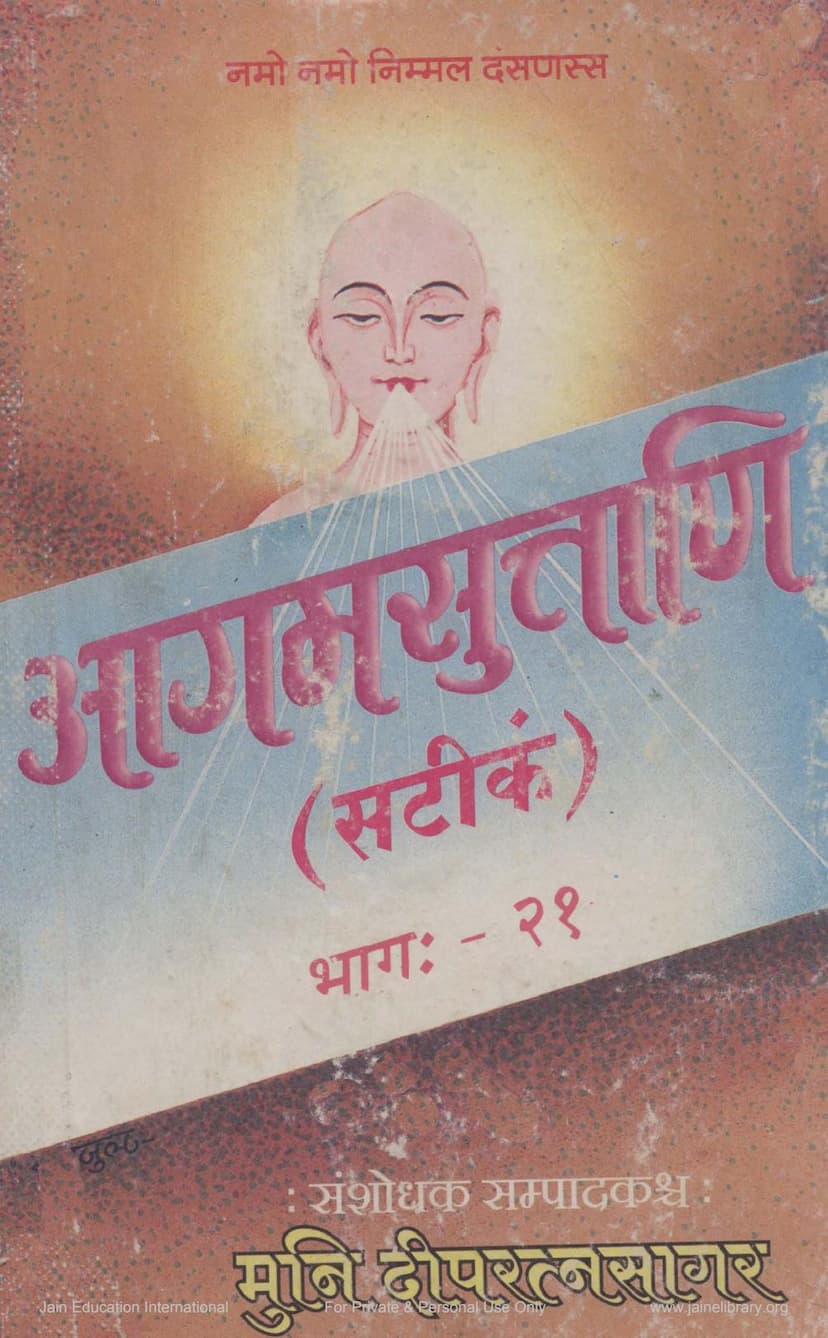Agam Suttani Satikam Part 21 Vyavahara
Added to library: September 1, 2025

Summary
This Jain text, Agam Suttani Satikam Part 21 Vyavahara, is a commentary on the Vyavahara Sutra, one of the fundamental texts of Jainism, specifically the Acharaṅga Sūtra's section on conduct. The provided pages offer a glimpse into the comprehensive nature of this commentary, which includes the original text, its elucidation, and potentially commentaries or interpretations (like Niryukti and Bhashya).
Here's a breakdown of the key elements and themes present in the provided text, based on the pages and their content:
1. Title and Authorship:
- Book Title: Agam Suttani Satikam (Part 21) Vyavahara
- Authors/Editors: Dipratnasagar, Deepratnasagar
- Publisher: Agam Shrut Prakashan
- Context: Jain Education International, for private and personal use only. This indicates its use within a specific educational or organizational framework.
2. Content Outline (from the Table of Contents): The table of contents (Page #3) provides a clear structure for this section of the Vyavahara Sutra, indicating that Part 21 covers:
- Pithika (Preface/Introduction): This section likely sets the stage, explaining the context, importance, and methodology of the Vyavahara Sutra. It includes:
- Mangala (Auspicious invocation)
- Prastavna (Introduction)
- Vyavahara - Shabdaratha (Meaning of the word 'Vyavahara')
- Prayashchitta-Dwaram (Chapter on Penance/Expiation)
- Naya Vyavahara (Conduct according to different logical perspectives)
- Alochanadi Prayashchittani (Penances like confession, etc.)
- Vinaya Prarupaṇa (Elucidation of etiquette/respect)
- Prayashchitta-dāna-vidhih (Method of administering penance)
- Uddeshak- 1 (Chapter 1):
- Alochanā Prayaschitta (Confession as penance)
- Parihāra Kalpasthitasya Vidhih (Procedure for the accepted/approved monastic period)
- Gaṇa Praveśa Viṣayaka Vidhānāni (Rules regarding entering a monastic order)
- Punaḥ Pravrajyā Vidhānam (Rules for re-initiation)
- Ālochanā Karaṇe Vidhih (Method of confession)
- Uddeshak- 2 (Chapter 2):
- Prayaschitrakālaṁ kiñcid Vaktavyatā (Discussion on the duration of penance)
- Gaṇāvachedakaraṇe Niṣedhaḥ (Prohibition of becoming a head of a sub-sect/group)
- Gaṇāvachedaka pada (The position of Gaṇāvachheda)
- Āchārya Upādhyāya pada (The positions of Acharya and Upadhyaya)
- Parihāra Kalpasya Āhāra Vyavahāra Ādiḥ (Conduct related to sustenance during the Parihara period)
- Sthavira-Vaiyāvr̥ttyam (Service to the elders)
- Uddeshak- 3:
- Gaṇa-Adhipati Vidhih (Rules for the head of a monastic group)
- Upādhyāya pada Vidhānam (Rules regarding the position of Upadhyaya)
- Āchārya Upādhyāya pada (Positions of Acharya and Upadhyaya)
- Uddeshak- 4: Mentioned as continuing in the next part.
3. Core Themes and Concepts: The pages reveal that the Vyavahara Sutra, and by extension this commentary, deals with the practical aspects of monastic life and conduct within Jainism. The recurring themes are:
- Prayashchitta (Penance/Expiation): This is a central theme. The text details various forms of penance (Alochanā, Parihāra Kalpa, etc.) and the procedures for administering them.
- Vinaya (Conduct/Etiquette): The importance of proper conduct and respect towards elders, fellow ascetics, and the rules of the order is emphasized.
- Āchārya and Upādhyāya: The roles, responsibilities, and rules governing these senior monastic positions are discussed.
- Monastic Rules and Procedures: The text likely outlines rules for daily life, interactions within the monastic community (Sangha), and the proper conduct in various situations.
- Interpretive Methodology: The commentary delves into the nuances of the sutras, explaining terms like 'Vyavahara,' and discussing different approaches (like 'Naya Vyavahara'). The detailed breakdown of the text's structure with pithika, uddheshak, and detailed subject points suggests a rigorous analytical approach.
- Types of Offenses and Punishments: The text seems to categorize offenses and prescribe specific penances, possibly based on the severity and nature of the transgression.
- Āgama Śruta: The text is presented as part of the Āgama Śruta, the authoritative scriptural canon of Jainism, emphasizing its scriptural importance.
4. Commentary Style: The presence of terms like "Satikaṁ" (with commentary), and the mention of works like "Niryukti," "Bhāṣya," and "Ṭikā" (commentary) by specific scholars (Bhadrabāhu Swāmī, Saṅghadāsa Gaṇi, Malayagiri Āchārya) indicates a rich tradition of textual analysis and scholarly engagement within Jainism. The sheer depth of the subject matter, as outlined, points to a highly detailed and systematic explanation of the Vyavahara Sutra's principles.
In essence, this part of the Vyavahara Sutra commentary serves as a detailed manual for Jain monks, guiding them on the intricacies of ethical conduct, disciplinary rules, and the process of purification through penance, all within the framework of their spiritual path.